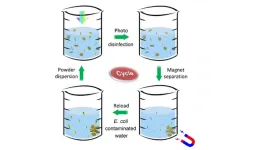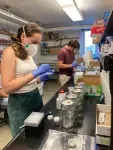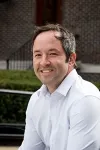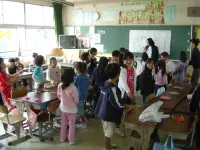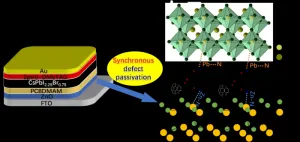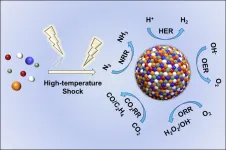(Press-News.org) At least 2 billion people worldwide routinely drink water contaminated with disease-causing microbes.
Now Stanford University scientists have invented a low-cost, recyclable powder that kills thousands of waterborne bacteria per second when exposed to ordinary sunlight. The discovery of this ultrafast disinfectant could be a significant advance for nearly 30 percent of the world’s population with no access to safe drinking water, according to the Stanford team. Their results are published in a May 18 study in Nature Water.
“Waterborne diseases are responsible for 2 million deaths annually, the majority in children under the age of 5,” said study co-lead author Tong Wu, a former postdoctoral scholar of materials science and engineering (MSE) in the Stanford School of Engineering. “We believe that our novel technology will facilitate revolutionary changes in water disinfection and inspire more innovations in this exciting interdisciplinary field.”
Conventional water-treatment technologies include chemicals, which can produce toxic byproducts, and ultraviolet light, which takes a relatively long time to disinfect and requires a source of electricity.
The new disinfectant developed at Stanford is a harmless metallic powder that works by absorbing both UV and high-energy visible light from the sun. The powder consists of nano-size flakes of aluminum oxide, molybdenum sulfide, copper, and iron oxide.
“We only used a tiny amount of these materials,” said senior author Yi Cui, the Fortinet Founders Professor of MSE and of Energy Science & Engineering in the Stanford Doerr School of Sustainability. “The materials are low cost and fairly abundant. The key innovation is that, when immersed in water, they all function together.”
Fast, nontoxic, and recyclable
After absorbing photons from the sun, the molybdenum sulfide/copper catalyst performs like a semiconductor/metal junction, enabling the photons to dislodge electrons. The freed electrons then react with the surrounding water, generating hydrogen peroxide and hydroxyl radicals – one of the most biologically destructive forms of oxygen. The newly formed chemicals quickly kill the bacteria by seriously damaging their cell membranes.
For the study, the Stanford team used a 200 milliliter [6.8 ounce] beaker of room-temperature water contaminated with about 1 million E. coli bacteria per mL [.03 oz.].
“We stirred the powder into the contaminated water,” said co-lead author Bofei Liu, a former MSE postdoc. “Then we carried out the disinfection test on the Stanford campus in real sunlight, and within 60 seconds no live bacteria were detected.”
The powdery nanoflakes can move around quickly, make physical contact with a lot of bacteria and kill them fast, he added.
The chemical byproducts generated by sunlight also dissipate quickly.
“The lifetime of hydrogen peroxide and hydroxy radicals is very short,” Cui said. “If they don't immediately find bacteria to oxidize, the chemicals break down into water and oxygen and are discarded within seconds. So you can drink the water right away.”
The nontoxic powder is also recyclable. Iron oxide enables the nanoflakes to be removed from water with an ordinary magnet. In the study, the researchers used magnetism to collect the same powder 30 times to treat 30 different samples of contaminated water.
“For hikers and backpackers, I could envision carrying a tiny amount of powder and a small magnet,” Cui said. “During the day you put the powder in water, shake it up a little bit under sunlight and within a minute you have drinkable water. You use the magnet to take out the particles for later use.”
The powder might also be useful in wastewater treatment plants that currently use UV lamps to disinfect treated water, he added.
“During the day the plant can use visible sunlight, which would work much faster than UV and would probably save energy,” Cui said. “The nanoflakes are fairly easy to make and can be rapidly scaled up by the ton.”
The study focused on E. coli, which can cause severe gastrointestinal illness and can even be life-threatening. The U.S. Environmental Protection Agency has set the maximum contaminant-level goal for E. coli in drinking water at zero. The Stanford team plans to test the new powder on other waterborne pathogens, including viruses, protozoa, and parasites that also cause serious diseases and death.
Yi Cui is director of the Precourt Institute for Energy and the Sustainability Accelerator in the Stanford Doerr School of Sustainability. He is also a professor of photon science at SLAC National Accelerator Laboratory. Bofei Liu is now a research scientist at EEnotech Inc., a water purification spinoff co-founded by Cui. Tong Wu is on the faculty of Tonji University in Shanghai.
Other Stanford co-authors are Harold Y. Hwang, professor of applied physics in the School of Humanities and Sciences and professor of photon science at SLAC; former engineering postdocs Chong Liu, Jiayu Wan, Feifei Shi, Ankun Yang, Kai Liu and Zhiyi Lu; and former engineering PhD students Jie Zhao and Allen Pei.
END
New non-toxic powder uses sunlight to quickly disinfect contaminated drinking water
2023-05-18
ELSE PRESS RELEASES FROM THIS DATE:
Some climate-smart agricultural practices may not be so smart
2023-05-18
-Several practices being promoted as climate smart could lead to land use spillovers that change their net impact on climate
-Most evidence is that cover cropping with rye, as done in the US, causes a yield loss. We show that the land use spillovers can then negate most of the climate benefit of cover cropping.
-The method and data we used were made available (as an R package) so that others can apply the same approach to other questions related to land use spillovers END ...
Keeping California’s oil in the ground will improve health but affect jobs
2023-05-18
(Santa Barbara, Calif.) — As society reckons with climate change, there’s a growing call to keep fossil fuels right where they are, in the ground. But the impact of curtailing oil production will depend on the policies we implement to achieve this.
An interdisciplinary team of researchers investigated the carbon emissions, labor and health implications of several policies to reduce oil extraction, with a special focus on how the effects vary across different communities in California. Their results, published in Nature Energy, ...
Biodiversity discovery: Unknown species ("dark taxa") drive insect diversity
2023-05-18
Biodiversity loss ranks among the top three risks to humanity, as stated in the 2023 World Economic Forum Global Risks Report. Understanding biodiversity's basic building blocks is essential to monitor changes, identify influencing factors, and implement appropriate policies. However, much of terrestrial animal diversity, including insects, remains unknown or "dark taxa."
For example, the global biodiversity information portal GBIF has nine times more information on birds than insects and arthropods, despite birds only accounting ...
Climate change to push species over abrupt tipping points
2023-05-18
Climate change is likely to abruptly push species over tipping points as their geographic ranges reach unforeseen temperatures, finds a new study led by a UCL researcher.
The new Nature Ecology & Evolution study predicts when and where climate change is likely to expose species across the globe to potentially dangerous temperatures.
The research team from UCL, University of Cape Town, University of Connecticut and University at Buffalo analysed data from over 35,000 species of animals (including mammals, amphibians, reptiles, birds, corals, fish, cephalopods and plankton) and seagrasses from every continent and ocean basin, alongside climate projections running up to 2100.
The ...
Engineering: The house that diapers built
2023-05-18
Up to eight percent of the sand in concrete and mortar used to make a single-story house could be replaced with shredded used disposable diapers without significantly diminishing their strength, according to a study published in Scientific Reports. The authors suggest that disposable diaper waste could be used as a construction material for low-cost housing in low- and middle-income countries.
Disposable diapers are usually manufactured from wood pulp, cotton, viscose rayon, and plastics such as polyester, polyethylene, and polypropylene. ...
Why do Japanese teachers seem unready to teach critical thinking in classrooms?
2023-05-18
Globally, critical thinking (CT) is regarded as a highly desirable cognitive skill that enables a person to question, analyze, and assess an idea or theory from multiple perspectives. CT has become an integral and mandatory part of global educational curricula, but its definition varies across contexts and cultural backgrounds.
To assess the implementation of CT, the Organization for Economic Cooperation and Development (OECD) conducts the Teaching and Learning International Survey (TALIS). In a 2018 survey (TALIS 2018), only 12.6% of lower secondary ...
Boosting solar cell energy capture efficiency with a fullerene-derivative interlayer
2023-05-18
Solar cells are a critical component to the transition to renewable energy sources, and enhanced power conversion efficiency (PCE), or amount of power captured with a given amount of sunlight, increases the practicality of solar power in a society with high energy demands. Perovskite solar cells that use all-inorganic perovskite light-absorbing materials are more thermally stable than organic-inorganic hybrid counterparts, but suffer from lower PCE. Researchers have overcome this hurdle in all-inorganic perovskite solar cells ...
Children’s Cancer Research Fund backs cutting-edge leukemia research at UVA
2023-05-18
Children’s Cancer Research Fund has awarded $250,000 to an innovative new approach to treating leukemia – blood cancer – being developed at UVA Cancer Center.
The grant to John H. Bushweller, PhD, of the University of Virginia School of Medicine, is part of the national nonprofit’s efforts to accelerate the development of new and better treatments for difficult-to-treat cancers.
“This funding makes it possible to continue developing a novel approach to treatment for a form of pediatric leukemia with a very poor prognosis,” said Bushweller, of UVA’s Department of Molecular Physiology and Biological Physics. “For ...
Research to improve quality of stroke care is advancing but gaps exist
2023-05-18
INDIANAPOLIS – Every 40 seconds, someone in the U.S. has a stroke. Every 3.5 minutes, someone in the U.S. dies of a stroke. Stroke patients have multifaceted needs, requiring complicated care delivered by multidisciplinary teams.
In the journal Stroke’s annual review of quality improvement advances in stroke care studies, Regenstrief Institute Research Scientist Dawn Bravata, M.D., and colleagues update researchers, clinicians and healthcare administrators on advances in the field, highlighting the challenges of scalability and sustainability.
“Quality improvement exists to ensure that every patient with stroke or at risk of stroke is getting the care ...
High-temperature shock synthesis of high-entropy alloy nanoparticles for catalysis
2023-05-18
High-temperature shock (HTS) is an emerging synthesis method with kinetics-dominated non-equilibrium characteristics, which can achieve an ultrafast heating/cooling rate of ~10^5 K/s and a peak temperature larger than ~3000 K within a time scale of seconds or milliseconds, and is widely used in the preparation of high entropy content, thermodynamic metastable phase and defect-rich materials. Amongst these significant advances, nanoscale high entropy alloys (HEA) are particularly prominent in heterogeneous catalytic reactions with remarkable ...
